sailing homepage :
trip reports :
3: cabo to pv :
las frailes
Previous: 3: cabo to pv
Next: ensenada de los muertos
Nov 13-16: Passage from Cabo San Lucas to Las Frailes anchorage, hanging out, snorkeling, and chilling
We raised anchor at first light and motored out of the bay. We were all ecstatic to be leaving. Never before have we been so happy to get away from somewhere.
It hadn't been a comfortable night - a tropical depression off Acapulco, some 600nm south, was generating fairly large rollers that were coming right into Cabo's otherwise-protected bay. We had been rocking and rolling quite a bit, and without the assistance of alcohol to help us sleep, it wasn't fun.
The storm was strange - it formed very late in the season - and we hadn't expected it to continue to last. Everyone we talked to thought it would be long gone, but the low pressure region hung around and was to blame for the big rollers. The storm was dying though, and we weren't worried about it.
As we moved out of the bay we heard some VHF calls from boats who had left earlier; they were a bit panicked! People were talking about huge winds that weren't forcasted, about how they had reefed and double-reefed their sails in order to keep calm. Wussies.
|
|
We still had our big 155% genoa up, and as soon as we caught the wind it was clear we were overcanvassed. Our leeward rail was almost immediately underwater, the boat was surging forward with a roar, and because we were pushing almost straight into the wind, we were being drenched with sheets of water.
We decided to change sails underway, something we had only done in calm seas or at anchor before. It was good practice, but pretty much everything that could go wrong did go wrong.
We turned on the motor and drove close to the wind to depower the sail. We could have done this by adjusting the main and carefully manning the helm, but the motor is a nice insurance policy against things getting out of hand. Our direction change made lowering the sail much easier, but it also took us straight into the steep waves.
The bow was rising and falling with each wave, and we were being totally drenched in spray. It was hard to see, the spray and salt would burn your eyes when they were open. The only consolation was the water temperature, 80F, which was nice and pleasant.
The sail wasn't coming down - I think I started pulling before Sean had released the halyard - and when the luff was tensioned with my bodyweight, a D-ring failed! Yes, a new stainless-steel D-ring came apart. These things are never supposed to fail; we can only imagine that the screw wasn't fastened or locked in place.
We hauled the sail down, did a quick fold job, tied it up, and packed it into a sail bag tied on the bow. No problems, but now we couldn't fasten the new sail to the car on the furling headstay: we were missing the hardware to connect the sail, oh yeah, plus the car was all the way up at the top of the mast!
This sucked, and we spent a lot of time thinking about what to do. Sean went below and found a new D-ring - very necessary - and I contemplated climbing the mast in the crazy seas. Sara was at the helm, and while we were trying to figure out what to do, had cracked off the wind and eased our passage through the waves.
The car is rides on a track that rotates freely around the headstay; it is pulled up the track by the jib halyard, the top of the sail attaches to the car, and when the track is spun by the roller furler, the sail wraps up around itself. When the car is connected to the sail, you can pull it down by freeing the halyard and pulling on the sail. When a D-ring fails, the car can't be pulled down.
The car was stuck at the top of the headstay, some 45' above the deck. It wasn't heavy enough to slide down the headstay - the weight of the wire/rope halyard inside the mast was more than the weight of the car.
It was a dilemma: unless we could retrieve the car, we would be unable to use a headsail; sailing on main alone would suck; climbing the mast would be suicide; returning to Cabo was not an option.
|
|
After a lot of thought, we decided to try to retrieve the car. I took one of the backup halyards connected to the masthead and lead it forward to the bowsprit. I lashed myself in and tried to hang on while working. I pulled the halyard almost all the way in one direction, tied a big knot in the middle of the line, and pulled the halyard in the other direction. This moved the knot up towards the block at the masthead.
After some delicate manouvering, I managed to get the knot past the car. I then tensioned both ends of the halyard along the headstay, and slowly pulled the knot back down towards me.
It took a lot of work, but slowly the car moved down the track a few feet. Woohoo! Unfortunately, as the knot moved lower and further away from the masthead, it became harder and harder to tension the lines enough to keep the knot next to the car. Hmm.
Okay, new tactic: I tensioned the un-knotted end of the halyard and whipped the knotted end around the headstay. After twenty or thirty tries, I managed to get a wrap behind the car. Perfect! A little tension and lots of back/forth with the halyard, plus several more wraps behind the car, and we managed to get it down to deck level.
I was drenched, exhausted, and a little sea-sick when it finally came down within reach, but it was worth it. We were never going back to Cabo. If the rescue mission had not succeeded, we would have continued on under mainsheet alone.
Sean attached the smaller 100% jib with the new hardware, and we hauled it up. Instantly the motion of the boat was better - we punched through waves easier, stayed at a constant angle, were getting much less wet. We were finally able to relax a little.
|
|
We tacked back/forth around the wind the rest of the day, motorsailing occasionally to keep up our forward momentum (velocity made good to our waypoint). We were traveling with five or six other boats, most of whom were just motoring straight into the wind/waves. After a wet and messy start, it turned into a great day of sailing, but the conditions were stronger than forecast.
We arrived in Las Frailes before sundown, found a great spot to drop our hook among the ten or twelve boats already there, and settled in for the evening. With the two-week rush down the Baja peninsula - we took a month to do the same distance down the California coast, and even that felt like we were hurrying - and the craziness of Cabo, we were all looking forward to just camping out for a while.
We launched the dinghy, let out some extra anchor rode, turned off our radio, watched a movie, and slept peacefully in a beautiful protected anchorage (with no southern swells) for the first time in what felt like forever.
Unbeknownst to us, tropical depression 20E did not dissipate as forecast; it was in the process of increasing in strength. At 9PM it was officially designated a tropical cyclone. Ten hours later it upgraded again to 'tropical storm'. Cyclone sounds more intimidating than storm, but I guess either is bad news. With our radio off we were blissfully unaware.
Tuesday the 14th, was a great day. We didn't do much.
|
|
We spent the first half of the day lazily doing a few boat chores. I marked the anchor chain with zip-ties - the perminant marker solution we implemented in San Diego wasn't working at all, the marks were too hard to see - and Sean installed our wind scoop on the forward hatch.
|
|
|
|
|
We went swimming, we watched a few movies, and lazed about all day. Sometime after lunch Sara bought a fish from a local fisherman - $5 for the most beautiful red snapper you've ever seen. We decided to try something new and cook our fish whole, which required our fishing bible for guidance, and some intestinal fortitude while eating.
|
|
|
|
|
Snappy the red snapper was delicious, but the cold glassy stare of our dinner was a bit unnerving. I guess we got past it: we picked him to the bone. We watched yet another movie and went to bed. Apart from the fisherman, I don't think we spoke to another soul. A few boats arrived, and many left, but we just hung out and did our own thing.
Wednesday the 15th was another great day. We did nothing again.
I think we watched two movies, both about the American civil war. Both were multi-volume epics that individually were never meant to be watched straight through.
|
|
We read. We played on the computer. That's it, that's all we did.
Our unknown friend - the tropical storm off Acapulco - had been quietly organizing itself, and sometime during the day it was officially upgraded again and named Hurricane Sergio. Before the end of the day Sergio was officially a category 2 hurricane, generating 110mph (175kph) winds, and was starting to move north. We had no idea. It's probably why so many people left our beautiful little spot.
Thursday the 16th was yet another great day. We were sick of civil war movies, Sara was ready to kill Sean and me due to our horrible impersonations of Southern accents, so we decided to check out the nearby reef. The only living coral reef in Mexico! "Why ma'am, I do not believe I have evah seen any cohal aheefs in the sovahn state of Viahginia".
We loaded up Purpeat with our snorkel gear, dinghy anchor and rode, Sean's waterproof camera, and a ton of snacks and drinks, and hopped in. We even brought the stupid dinghy wheels the Baja-haha people had convinced us to buy. Hopefully one day we can use these things and justify the $150 we spent on them. So far they've been a bit of a disappointment.
|
|
We motored into the waves for more than an hour, but our efforts were rewarded: the reef is beautiful, and totally covered in marine wildlife. Thousands of fish, hundreds of different species, and only one other person drifting around on a sea kayak.
|
|
|
|
|
We had a great time, and returned both exhausted and exhilirated. Over pizza dinner that evening - nice one, Sean - we played a wicked game of Balderdash: "topolobampo, a traditional phrase of greeting spoken by native americans, topolobampo".
|
|
Sleep came fast. In fact, we always sleep well when we're oblivious of hurricanes bearing down on us.

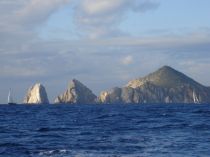 Leaving Cabo
Leaving Cabo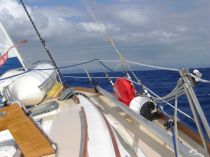 Driving hard into the wind and waves
Driving hard into the wind and waves Will at the helm; messy weather early
Will at the helm; messy weather early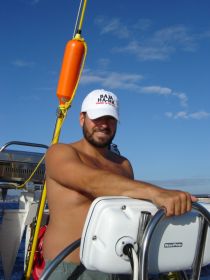 Sean at the helm; calmer sailing later
Sean at the helm; calmer sailing later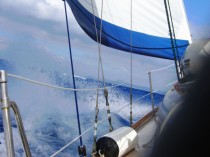 Kicking up some spray
Kicking up some spray Sara hiding out next to the genoa
Sara hiding out next to the genoa Sean made some dough for pizza
Sean made some dough for pizza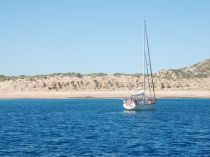 Our anchorage was picturesque
Our anchorage was picturesque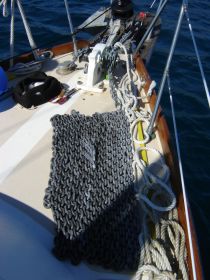 Marking the anchor chain with zipties
Marking the anchor chain with zipties Sean installing the windscoop
Sean installing the windscoop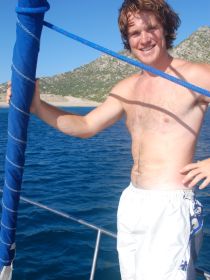 Posing after letting the chain back out
Posing after letting the chain back out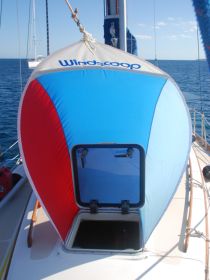 The windscoop in all its glory
The windscoop in all its glory How to eat a fish in three easy steps
How to eat a fish in three easy steps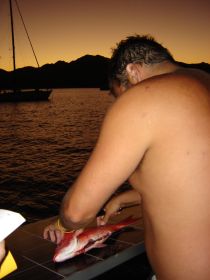 First, gut your fish and scrape out internals
First, gut your fish and scrape out internals Second, remove scales with a spoon
Second, remove scales with a spoon Third, cook fish and don't eat the eye
Third, cook fish and don't eat the eye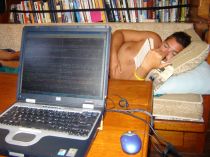 Reading and webpage work
Reading and webpage work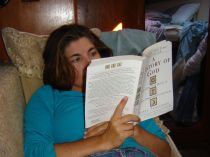 Reading and relaxing
Reading and relaxing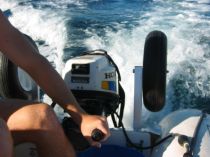 Sucky churning away
Sucky churning away Guano-covered rocks
Guano-covered rocks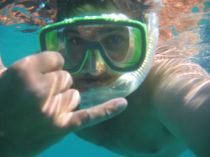 Sean having fun
Sean having fun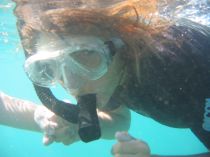 Sara is either cold or angry
Sara is either cold or angry Will is lost; where are the fish?
Will is lost; where are the fish? Beautiful coral reef
Beautiful coral reef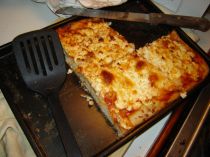 Mmmmm pizza
Mmmmm pizza Sara invents a new word
Sara invents a new word